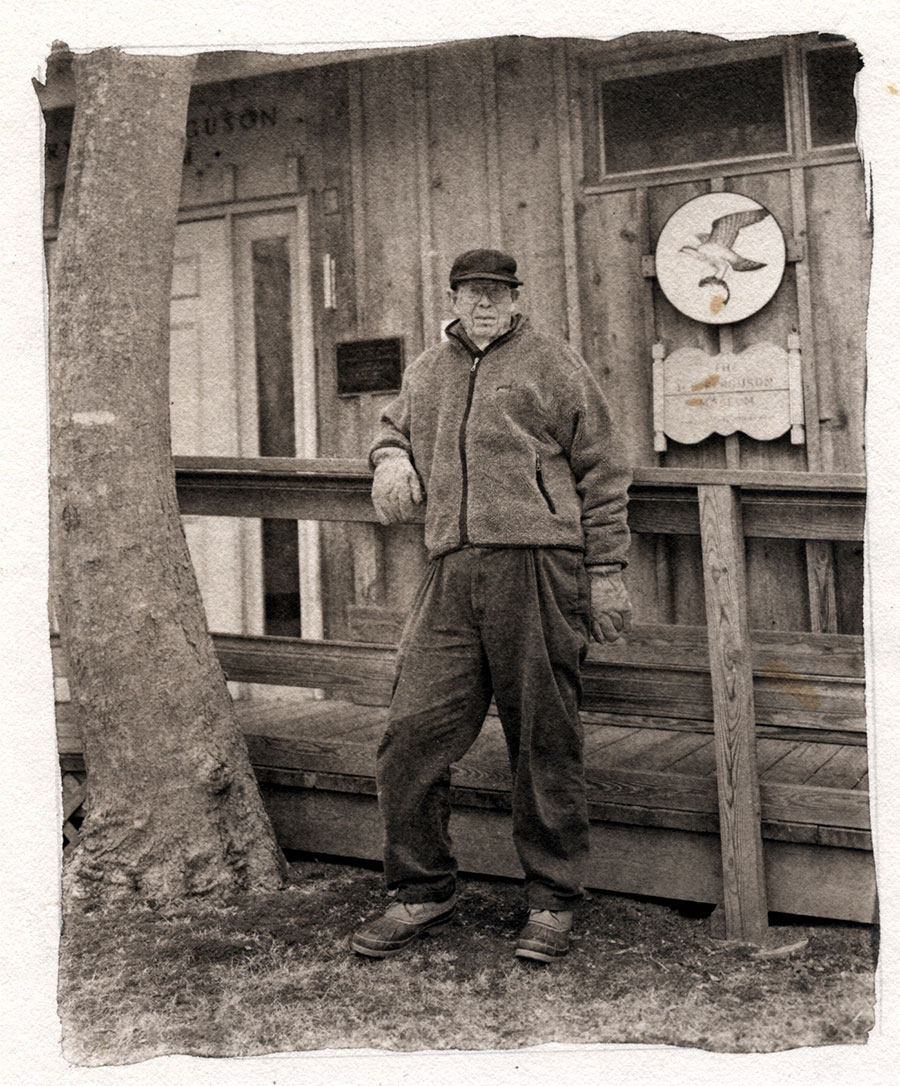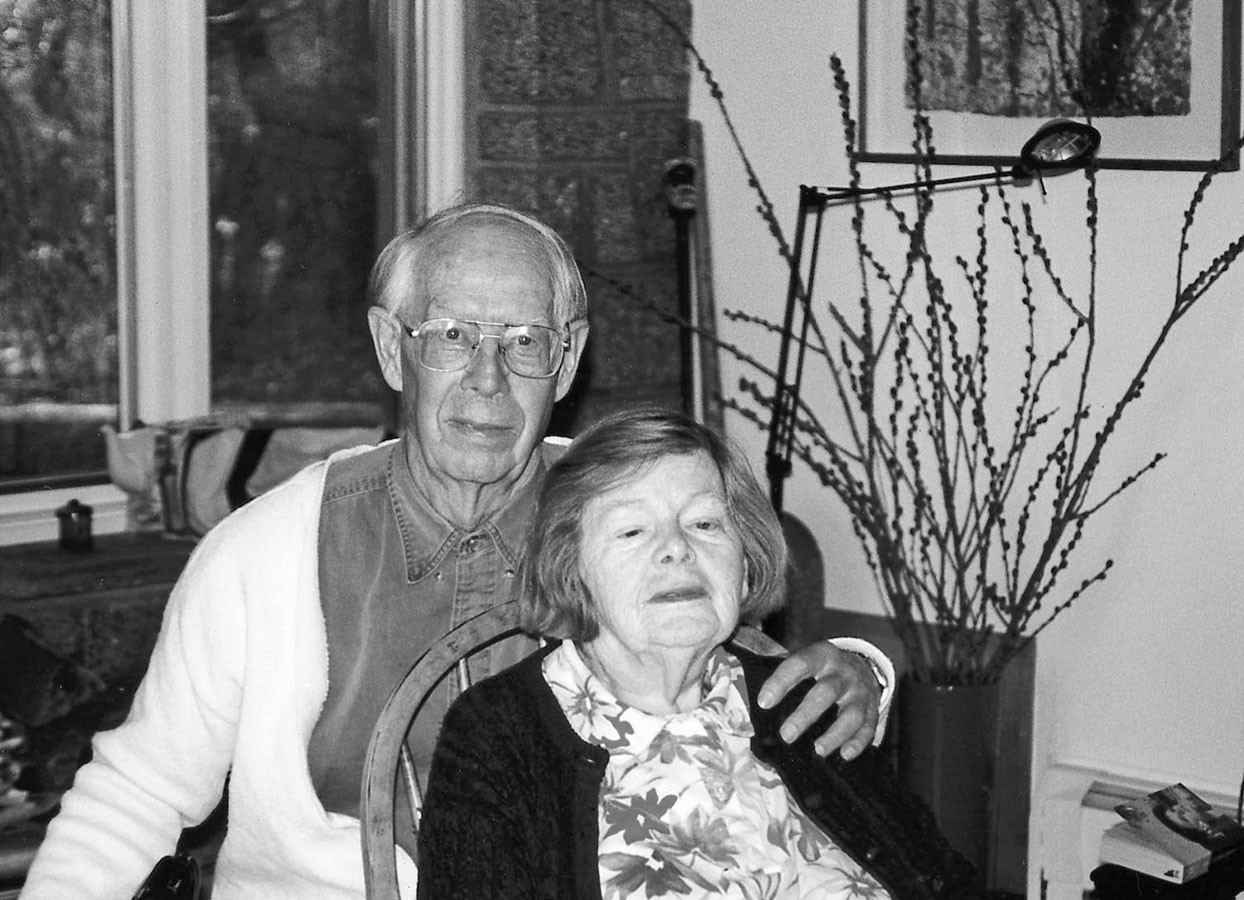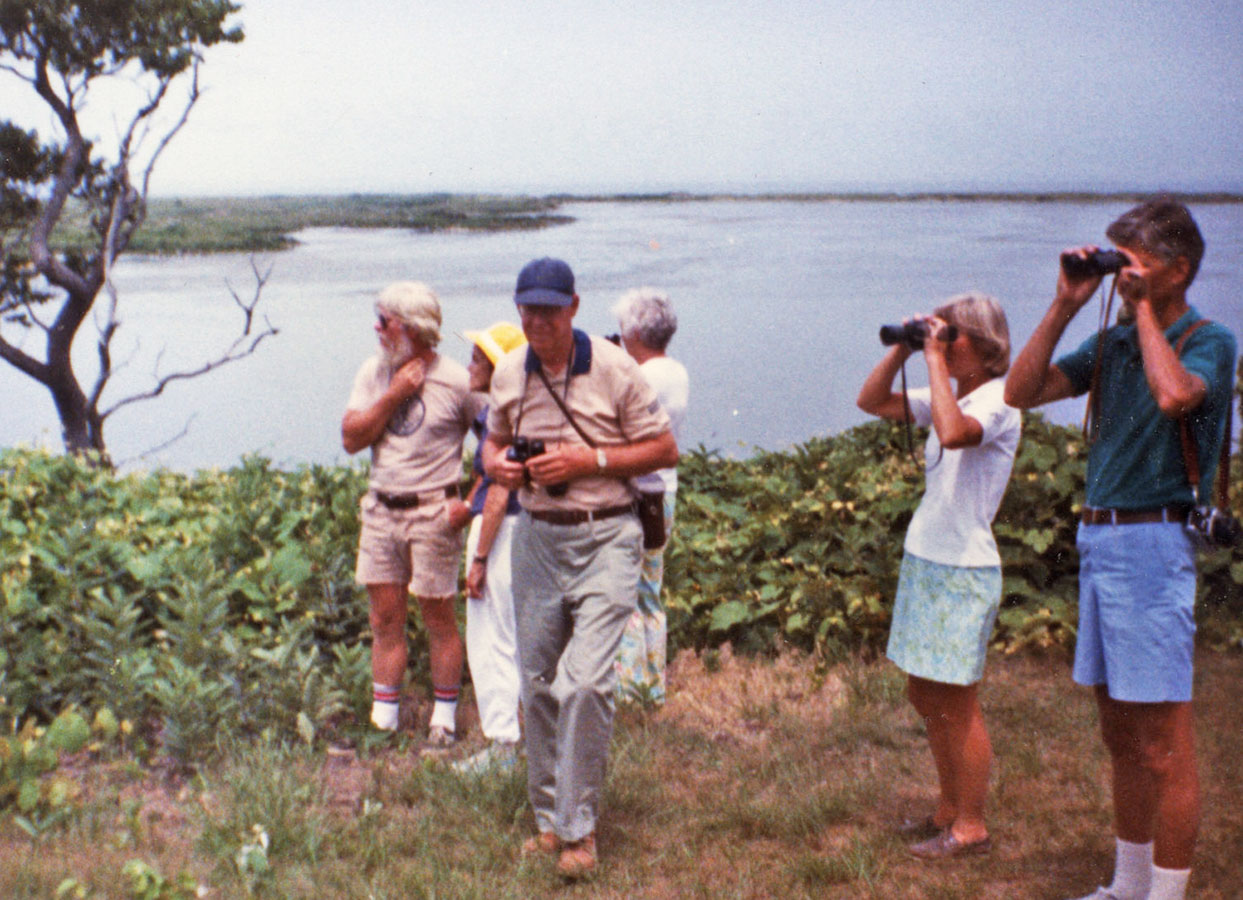Edwin H. Horning
Edwin H. Horning, who passed away on August 28, 2008, first came to Fishers Island as a school teacher in 1951. He joined the Board of Trustees of the H.L. Ferguson Museum at its inception in 1960 and became the Museum’s third curator in 1970, taking over that position from Charles B. Ferguson, who had succeeded his brother Lee Ferguson. For more than three decades, Mr. Horning, assisted by his wife Katherine, provided inspiring educational experiences to all who came into the Museum or joined him on his illuminating nature walks. Mr. Horning, as he was known to many of us, was a naturalist in the truest sense. He kept detailed notes on the natural history of the island, recorded birds seen on his frequent rounds and took the temperature of the water in Silver Eel Cove on a daily basis. He touched many lives and instilled respect and love of nature in many of his students.
To honor Ed’s years of service to the Museum, we dedicated the Museum’s Natural History section in his memory on June 26, 2009 by planting memorial trees at the Museum, the movie theater and the school. Tree species had been selected that provided cover and food resources for birds.
An Autobiography by Edwin H. Horning
The following autobiography was written circa 1976 or 1977. It was kindly provided for publication by his daughter Martha
For the past twenty-six years I have lived on Fishers Island. My wife, Katherine, and I are now busy settling in to our newly purchased home. From the bedroom window of this fifty year old house, we can see a nearby pond with its surrounding carpet of marshland plants and a muskrat feed house, and about a hundred yards beyond are the shores of the Atlantic Ocean.
My present habitat on Fishers Island is in many ways quite different from the wooded hilly Allegheny Plateau of western New York where I was born on September 24, 1919. The wooded hills with their valley streams were to have a lasting influence on my life. One of my earliest memories was that of going chestnutting on a favorite hill called the sheep ranch. Memories still remain of gathering butternuts, blackberries, and once in a while, a ginseng root. One of the tributaries of the Allegheny River is the Great Valley Creek. Along the banks of this creek, I spent hours and sometimes days fishing, swimming, and in the winter trapping muskrats.
In the valley, my grandfather had a farm with dairy cows, a team of horses, pigs and chickens—a kindly grandmother, three uncles and an aunt. Every weekend I visited the farm, helping to feed and care for the animals and to harvest the crops. One of my favorite times was haying-in.
When I was six, my mother took me to visit the American Museum of Natural Science in New York City. It was a trip of enchantment and did much to stimulate in me an interest in natural history.
I graduated from Ellicottville High School in 1938 and during the following September I entered the College of Agriculture at Cornell University. At that time the tuition was free and I was able to live cheaply by rooming with three other boys and by cooking my own meals. I soon found Cornell to be the right place for me. Majoring in science teaching, I was most fortunate to have Dr. E. Lawrence Palmer as my major advisor. I still like to return to Cornell once in a while to look around. Now I have a good excuse for our youngest daughter, Kathy, is a first year student in the College of Agriculture and Life Sciences.
In March of 1942 I heeded a post card from the United States government beginning with GREETINGS, and going on to tell me where I was to report. Upon entering the United States Army, I was assigned to the Army Air Force. After basic training at Keesler Field in Biloxi, Mississippi, I attended a weather forecasting school at Chanute Field in Urbana, Illinois. Following a brief period of service at air bases in the United States, I was sent to England where I spent two years working with the ever changing English weather. As I spent one winter trapping muskrats, I noticed that the ice formed on the creek and broke up in a pattern as the weather changed in its cycles. While at Cornell I had taken a course in meteorology given by Dr. Merdoff. This course gave me a good general background. Working every day, observing and forecasting the weather for the Air Force greatly deepened my interest in the elements that make up the weather. Even today I make a daily record of the temperature, pressure, wind and precipitation on Fishers Island. For one year I took sea temperatures. An important part of my school science program is to find a child early each day and teach him or her to take a weather observation and to present it to the assembled group. Another weather school activity has been to help children reproduce the weather across the United States as shown on the daily weather map found in the New York Times.
Returning to the United States in 1945, I entered Teachers College Columbia University and majored in the teaching of science in the secondary school. I spent one year at Columbia and graduated with an M.A. While at Columbia I met and married Katherine, my wife. She was in the same field of education and we took many of the same classes.
Leaving Columbia we moved to Dover Plains, New York, where I taught high school science for two years. Our first child, Edwin, Jr., was born at Dover Plains. Recently we have returned on visits to Dover Plains as our daughter, Martha, now works in the nearby village of Wingdale. We moved from Dover Plains to the upstate village of Wyoming. At Wyoming I taught high school science and math for another two years. It was at Wyoming that our second son, George, was born. The area around Wyoming was one of fine farmlands on which the farmers practiced what they had learned at Cornell or from the county agent.
The following year was spent by our family at Ellicottville where our daughter, Martha, was born. While at Ellicottville I once again attended Teachers College, Columbia for the summer session. In the autumn I went to work for the Fancher Furniture factory. It was at this factory where I became aware of the many steps through which the native woods were put to become fine furniture. At the same time I became more keenly aware of the waste encountered in such production. I worked in this factory throughout the winter, and in the summer I enrolled in the State College for Teachers at Fredonia. By taking this step, I became an elementary teacher. I was to continue at Fredonia for four summer sessions.
In September of 1951 we moved to a place, the name of which I had never heard before, Fishers Island, New York. Through the many years on Fishers Island I have been the elementary science teacher and at times have taught high school biology and earth science. I greatly enjoyed teaching biology and earth science on a high school level and have found that they deepened my awareness, helping me to teach in a finer manner at the elementary level.
During my stay on Fishers Island I have attended Audubon Camps in Maine and in Connecticut. At the Maine Camp I was able to observe the breeding areas of the northern seabirds and at the Greenwich Camp in Connecticut I went on several excellent nature walks, an experience which was to help me later on when I conducted my own nature walks. I attended a conservation workshop at Oneida Lake. Other places where I took advanced work were the State Teachers College at Fredonia, State Teachers College at Oneonta, College of St. Rose in Albany, University of Connecticut at Storrs and Connecticut College in New London. The courses that meant the most to me were those taken at Connecticut College. They were Marine Algae given by Martine Villalard and Plant Taxonomy given by Dr. William Niering. The subject matter of both courses was of immediate use to me. Indeed I had long desired such knowledge of the plant life of my environment and was most ready to make such knowledge a part of me and share it with others.
Through the years I have found great enjoyment in finding, studying, sometimes collecting the minerals, plants and animals native to the Island. For many years I have led an Audubon Junior Club, taking field trips to a variety of habitats on Fishers Island probably found on few other places. At this point I would like to mention one person, who with his encouragement helped me greatly in my early work with birds on Fishers Island. He was the late H. Lee Ferguson. It was through Lee that I was appointed to the original board of trustees when the H.L. Ferguson museum was formed. I am at the present time the curator which enables me to easily coordinate the activities of the school children and other groups in the community with those of the museum. Last summer I arrange for Miss Helen Hays of the Museum of Natural History to tell us about her work with terns on Great Gull Island. People of all ages attended this affair and were enchanted with the illustrated lecture by Miss Hays.
Since 1966, I have kept a daily record of the kinds and numbers of birds seen on Fishers Island. Working with a young naturalist, Shepard Krech, I put together two editions of the Birds of Fishers Island.
Another young naturalist, Paul Spitzer, a doctorate candidate at Cornell University, has been studying the ospreys of the Island in an effort to halt the decline probably due to the use of pesticides, which has now been stopped. During the spring Paul comes to the Island and counts and bands the young ospreys. I have helped coordinate his activities with the Island people. Also, Paul stays at our home and truly enjoys Katherine’s cooking.
During December of every year I receive a telephone call from Bob Dewire of the Pequot-Sepos Nature Center asking me to take the Christmas bird count for the Island. This count becomes a part of the New London area count published in the American Birds.
Much of my work is done in a play by ear way. Sometimes it is a crippled bird to care for, at other times a dead bird to be identified or a porpoise skeleton to be collected. On several occasions students from Connecticut College have come to the Island to study parts of the environment. They contact me and I help them. They learn from me and I learn from them. One very special student came from Vienna, Austria. She was Verana Neusser. Verana came at the time I was making a count of colonial nesting birds on the Island. Although her main interest was an old world group, the counterpart of our North American warbler, Verana had done much work with gulls. She helped count the gulls on the Island and also taught me how to determine the three year old gulls from the adults.
For the past several years I have been a member of the Thames Valley Rockhounds. As a member of this group my knowledge of the rock and mineral world has greatly expanded and this knowledge I pass on to others. Each year I take the Audubon Junior Club to the annual rock and mineral show.
Other things I have done are: (1) Last summer I made a count shore birds; (2) Shepard Krech and I made a count of the common terns and of the least terns; (3) During the past autumn I took part in counting the hawks that migrated through Fishers Island; (4) For the past several summers I have conducted nature walks to the great variety of natural habitats on the Island. These walks are participated in by people of all ages and through the years the number of interested persons has grown steadily.
Through years of learning, doing and teaching, my interests in the natural sciences have expanded. I enjoy working with the many interwoven strands that make up natural science, some of the major strands being people, children and adults. When you become interested, enthusiastic, and work persistently in an area, good things seem to happen for you and for others.







